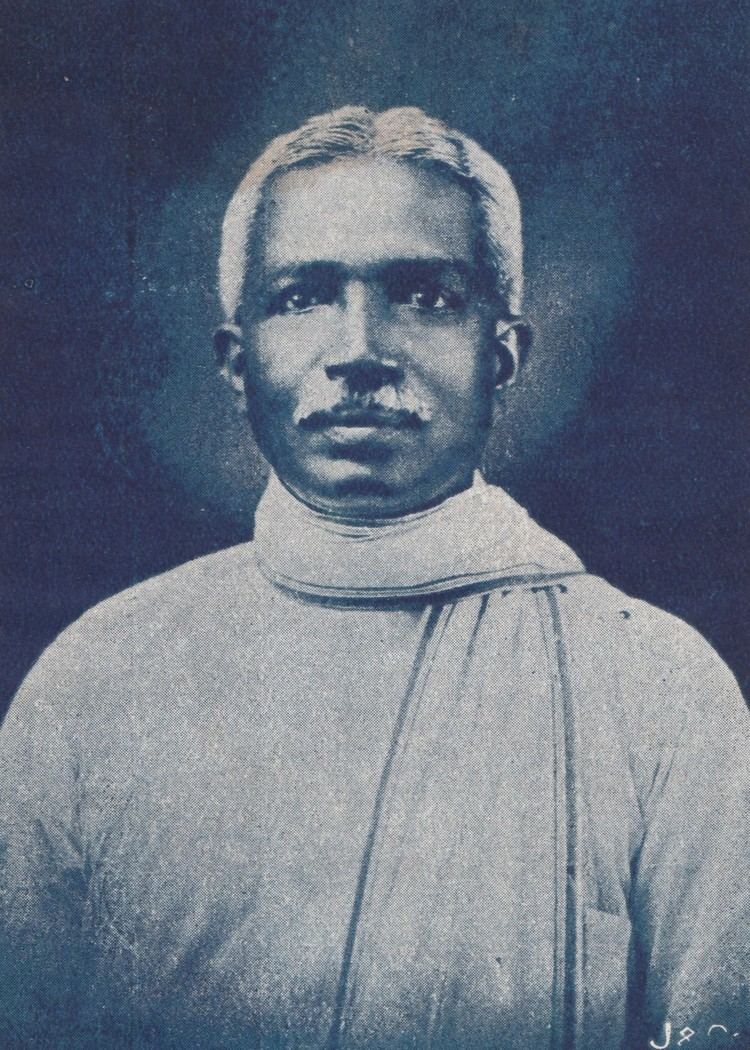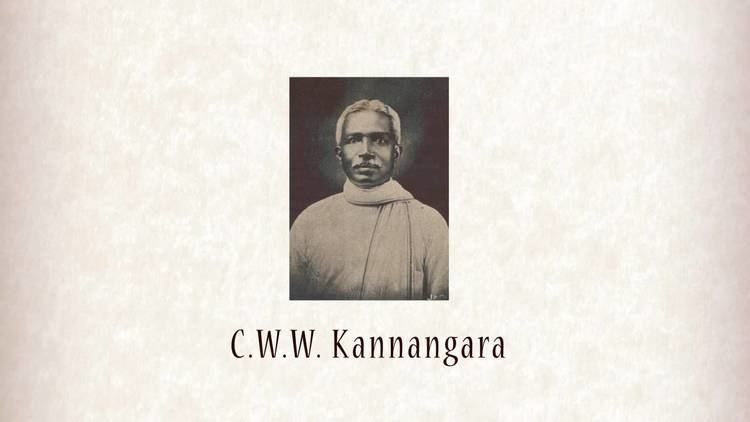Nationality Ceylonese (Sri Lankan) | Alma mater Richmond College Name C. W. Education Richmond College | |
 | ||
Died September 23, 1969, Colombo, Sri Lanka | ||
Christopher William Wijekoon Kannangara (Sinhala:සි.ඩබ්ලිව්.ඩබ්ලිව්.කන්නන්ගර;13 October 1884 – 23 September 1969) was a Sri Lankan lawyer and politician. Rising up the ranks of Sri Lanka's movement for independence in the early part of the 20th century, he became the first Minister of Education in the State Council of Ceylon, and was instrumental in introducing extensive reforms to the country's education system that opened up education to children from all levels of society.
Contents

Born in rural town in Balapitiya, South, Sri Lanka, his academic prowess enabled him to win a scholarship to Richmond College, Galle, a prestigious national school at the time. Initially working as a lawyer after leaving school, he entered politics as the movement for independence was gathering strength in Sri Lanka. Kannangara was first elected to the Ceylon Legislative Council in 1923 and then to the State Council. He also served as the President of the Ceylon National Congress.
As Minister of Education in the State Council, Kannangara introduced extensive reforms to the education system of Sri Lanka throughout the 1940s. They befitted thousands of underprivileged students in rural parts of the country by making education free for all students. He also began a Central Colleges scheme, which established high quality secondary schools in rural areas of the country. Kannangara's significant achievements in areas of education have led him to being commonly referred to as the Father of Free Education in Sri Lanka.
Early life
Crestoper William Wijekoon Kannangara was born on 13 October 1884, in Randombe, a rural village at Balapitiya in the south of Sri Lanka. The son of John Daniel Wijekoon Kannangara, the Deputy Fiscal Officer in the Balapitiya Courts, and Emily Wijesinghe, he had his primary education at the Wesleyan Missionary School in Randombe.
Kannangara showed great educational promise as a child, and his achievements were recognised by Rev. J.H Darrel, the Principal of Richmond College, Galle who was the chief guest at a prize giving of the Wesleyan Missionary School. After noticing that Kannangara won most of the available prizes, he is said to have remarked "Son, you may have to hire a bullock cart to take home the books you collected at this prize giving." Darrel also gave Kannangara a chance to sit for a Richmond College Foundation scholarship exam. Excelling in Mathematics in the exam, he won the scholarship, receiving an award for free board and lodging at Richmond College. There he received the education of an elite school of the times, far superior instructions to that offered at his rural school.
Kannangara was regarded as an excellent all-round student at Richmond, leading the Ceylon and British Empire list in Mathematics at the Cambridge Senior Examination in 1903. He also captained Richmond College in first eleven cricket in 1903, and was a member of the school soccer team the same year, winning colours for his performances. He was also regarded as a fine debater and actor. After leaving school, he taught Mathematics first at Richmond College and then Prince of Wales College, Moratuwa and Wesley College, Colombo. While teaching he studied law, passing out as an Attorney at law in 1910. He set up his first law practice in Galle the same year. He married Edith Weerasooriya in 1922.
State council
Kannangara joined Anagarika Dharmapala's historically significant temperance movement, and worked actively with its leaders, including Sir D.B. Jayatilleke, D.S. Senanayake, F.R. Senanayake and Arthur V. Dias. He rose to national prominence as a lawyer defending leaders of the Sri Lankan independence movement and others who were persecuted by the colonial British administration during the period of martial law which following the Riots of 1915. This also drew him into national politics, and in 1923 he entered the Legislative Council of Ceylon, winning a by-election on 13 April 1923 for a seat in the Galle District made vacant by the demise of O.C. Tillekaratne by 1969 votes to 115. He was re-elected the following year polling 4,177 votes, opposed to 2310 for his nearest opponent. Following the recommendations of the Donoughmore Commission, the State Council was established in 1931, succeeding the Legislative Council as the national legislature. Kannangara was elected to the State Council in 1931 and again in 1936. He also became the President of the Ceylon National Congress in 1931.
For the first time, the State Council, which had its members elected via universal suffrage, compromised Executive Committees and Ministers. Kannangara was appointed as the first chairman of the Executive Committee of Education in the State Council and thus became the first Minister of Education of Sri Lanka in 1931. Apart from Kannangara, the Executive Committee of Education consisted of H. W. Amarasuriya, W.T.B. Karaliyadda, A. Ratnayaka G.R. De Zoysa, P.E. Madawela and Dr. S. A. Wickramasinghe. He is also notable for being the first minister to wear the National costume in the State Council. During World War II, he was a member of the War Council.
Education reforms
Executive Committee of Education exercised its powers to create new regulations paving the way for the establishment of a new system of education in Sri Lanka. The new system was expected to ensure that education was provided with equal opportunities for all children in the country, irrespective of social class, economic condition, religion and ethnic origin. Whilst the education in vernacular schools had been free prior to the reforms due to government grants to cover the cost of teaching and local philanthropists providing the buildings, equipment and the books, it was not standardised. In 1942 a special committee was appointed with Kannangara as chairman to report on the status of education in the country. Among the recommendations for providing "lasting value to the nation" given in the report, which was published in 1943, were that
As Minister of Education Kannagara was placed in charge of implementing the recommendations. Among the reforms he introduced, which came into operation on 1 October 1945, were to make education free of charge for all students, to ensure that every student was provided with instruction in the religion of his/her parents, to prevent teachers from been exploited by managers of schools by having their wages paid directly by the government and to make adequate provisions for adult education in the country.
He also established a series of central schools (Madhya Vidhyala), modelled on Royal College, Colombo, in locations outside major cities. These took high quality secondary education to the rural outstations of the country. His objective was to create a central school in every electorate in the country, and as such, while in 1941 there were three central schools in the country; by 1945 the number had increased to 35, and to 50 by 1950. First Central College established in Akuramboda, Matale.In 1943 Kannangara also launched an annual scholarship program, which provided the opportunity for the 20 best performers of the scholarship exam to get free board and lodging in Central School hostels.
During his 16-year period as Minister of Education, he also upgraded ancient pirivenas, educational establishments for Buddhist monks, and established the University of Ceylon, the first University in Sri Lanka. Further, Kannangara took steps to abolished the two tier school system, where English was taught to privileged students and the vernacular language was taught to the rural masses. While he laid emphasis on teaching Swabasha (native languages) in schools, he also advised that students should learn English to compete in the modern world.
Opposition
Kannangara however faced significant opposition to his move to establish free education in the country, especially from socially and economically privileged groups who has enjoyed the significant advantages offered to them by the British. Significantly, this included a number of C.W.W Kannangara's political colleges, including D.S. Senanayake, the first Prime Minister of Sri Lanka. Kannangara spoke for six and a half hours to convince other members of the council to vote for the bill, and was supported in his efforts by H. W. Amarasuriya, Dudley Senanayake, J. R. Jayewardene, Sir Oliver Goonetilleke and Dr. N. M. Perera. There was also a public campaign launched by Dr. E. W. Adikaram, Professor G.P. Malalasekera and Mr. L. H. Metthananda to support the bill, which was eventually passed in the State Council in July 1945.
Post Independence
In appreciation of his services rendered to
His achievements in parliament in the field of Education did not however transfer to popularity among the people of his electorate, and he lost his seat in parliament in the General Elections of 1947. Ironically he was defeated in the poll for the Matugama electorate by Wilmot A. Perera, the founder of the popular local school Sri Palee College.
Kannangara was then appointed Ambassador to Indonesia, a post in which he served from 1950 to 1952. He returned to politics again, and was elected to parliament from the Agalawatta Electorate in 1952, defeating S.A. Silva. He was appointed Minister of Housing and Local Government in the new cabinet. He was likely denied the position of Cabinet Minister of Education as some leading figures in the government did not wish to give him the opportunity to carry forward further reforms to the education system.
C.W.W. Kannangara retired from active politics in 1956, and died on 23 September 1969. There are number of instituitions named after him in Sri Lanka.
A statue of C. W. W. Kannangara wmabahu Central College in Polgahawela.
